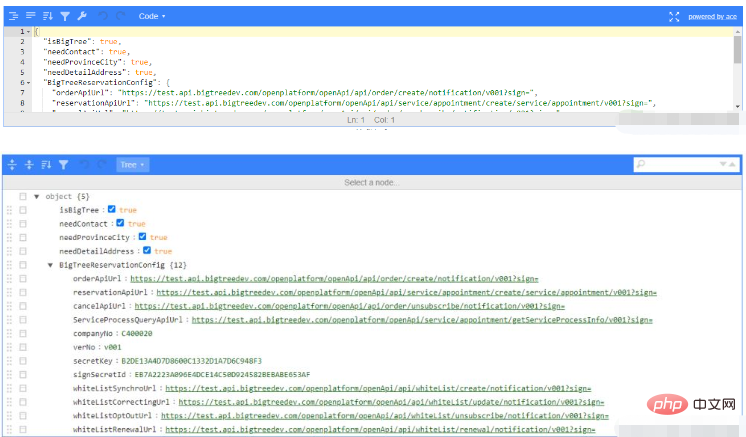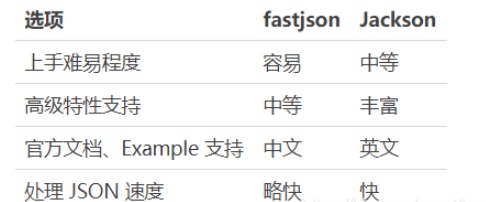JSON: JavaScript Object Notation
JSON syntax rules
Data in name/value pairs
Data is separated by commas
Curly brackets save objects
Square brackets save arrays
JSON has 6 types of values:
Object, array, string, number, Boolean value, null
A JSON object is an unordered collection of name/value pairs
Name: any string
Value: JSON value of any type, including arrays and objects (objects can be embedded in objects)
Note: JSON strings must use double quotes (single quotes will report an error)
1. Object
Create literals in javascript:
var object = {
name:"lily",
age:22
};
or:
var object = {
"name":"lily",
"age":22
};
JSON:
{
"name":"lily",
"age":22
}
2. Array
JSON array uses the array literal form in javascript
Extension:
Combining arrays and objects can form more complex data combinations
For example:
[
{
"name":"lily",
"age":22,
"job":"docter"
},
{
"name":"nicy",
"age":21,
"job":"teacher"
},
{
"name":"lily",
"age":22,
"job":"AE"
}
]
3. Parsing and serialization
JSON has a syntax similar to JavaScript and can parse JSON data structures into useful JavaScript objects
1.JSON object
Send and receive JSON data
When reading, writing, sending and receiving JSON data objects, they need to be converted into strings and can be converted from strings to JSON data objects. (read and write them the same way used for javascript)
JSON object has two methods:
① stringify(): Serialize javascript objects into JSON strings
② parse(): Parse JSON string into native javascript value
Example:
var book = {
title:"professional JavaScript",
authors:[
"lily"
],
edition:3,
year:2011
};
var jsonText = JSON.stringify(book);
alert(jsonText); //{"title":"professional JavaScript","authors":["lily"],"edition":3,"year":2011}
alert(typeof jsonText); //string
var bookCopy = JSON.parse(jsonText);
alert(typeof bookCopy); //object
In this example, JSON.stringify() is used to serialize a javascript object book into a JSON string, and then save it to jsonText; pass the JSON string jsonText directly to JSON.parse() to get the corresponding javascript Value
Note: When serializing JavaScript objects, the final values are instance properties of valid JSON data types, and any invalid values will be skipped
2. Serialization options
JSON.stringify() can receive two parameters when serializing JavaScript objects
Parameter 1: filter, which can be an array or function
Parameter two: an option indicating whether to retain indentation in the JSON string
1) Filter results
If the filter parameter is an array, the result of JSON.stringify() only contains the attributes listed in the array
For example:
var book = {
"title":"professional JavaScript",
"authors":[
"lily"
],
edition:3,
year:2011
};
var jsonText = JSON.stringify(book,["title","edition"]);
alert(jsonText); //{"title":"professional JavaScript","edition":3}
alert(typeof jsonText); // string
2) String indentation:
The third parameter of the JSON.stringify() method is used to control the indentation and whitespace characters in the result
3) toJSON() method
Define the toJSON() method for the object to return its own JSON data format
4. JSON access value
The first type: simple array
['item1','item2','item3']
Value: Access the embedded value via numeric index (the index of the first item is 0)
['item1','item2','item3']
var items = ['item1','item2','item3'];
alert(items[0]); // item1
Second type: Use {} to represent objects and arrays
{ "key":"value" }
Value: Access the embedded value through the key name
var oExample = { "name":"lily" };
alert(oExample.name); // lily
alert(oExample["name"]); // lily
Using these two methods, many data structures can be described in terms of subrecords (with named or numeric index keys):
For example:
var oNovelist = {
"firstName":"lily",
"lastName":"russ",
"novels":
[
{
"title":"and choas died",
"year":"1970"
},
{
"title":"the famale man",
"year":"1976"
}
]
};
var msg = oNovelist.firstName+" "+oNovelist.lastName+"'s"+" "+oNovelist.novels[0].title+" "+"was published in"+oNovelist.novels[0].year;
alert(msg); // lily russ's and choas died was published in1970
The above is the entire content of this article, I hope you all like it.
 VUE3怎么使用JSON编辑器May 12, 2023 pm 05:34 PM
VUE3怎么使用JSON编辑器May 12, 2023 pm 05:34 PM1、先看看效果图,可以自行选择展示效果2、这是我在vue3项目中使用的JSON编辑器,首先引入第三方插件npminstalljson-editor-vue3yarnaddjson-editor-vue33、引入到项目中//导入模块importJsonEditorVuefrom'json-editor-vue3'//注册组件components:{JsonEditorVue},4、一般后端返回的是会将JSON转为String形式我们传给后端也是通过这种形式,就可以通
 SpringBoot之Json的序列化和反序列化问题怎么解决May 12, 2023 pm 04:07 PM
SpringBoot之Json的序列化和反序列化问题怎么解决May 12, 2023 pm 04:07 PM控制json序列化/反序列化1.@JsonIgnoreProperties的用法@JsonIgnoreProperties(value={"prop1","prop2"})用来修饰Pojo类,在序列化和反序列化的时候忽略指定的属性,可以忽略一个或多个属性.@JsonIgnoreProperties(ignoreUnknown=true)用来修饰Pojo类,在反序列化的时候忽略那些无法被设置的属性,包括无法在构造子设置和没有对应的setter方法.2.@Js
 Java怎么调用接口获取json数据解析后保存到数据库May 14, 2023 am 10:58 AM
Java怎么调用接口获取json数据解析后保存到数据库May 14, 2023 am 10:58 AMJava调用接口获取json数据保存到数据库1.在yml文件中配置自己定义的接口URL//自己定义的JSON接口URLblacklist_data_url:接口URL2.在Controller中添加请求方法和路径/***@Title:查询*@Description:查询车辆的记录*@Author:半度纳*@Date:2022/9/2717:33*/@GetMapping("/Blacklist")publicvoidselectBlacklist(){booleana=imB
 深入解析JWT(JSON Web Token)的原理及用法Jan 10, 2023 am 10:55 AM
深入解析JWT(JSON Web Token)的原理及用法Jan 10, 2023 am 10:55 AM本篇文章给大家带来了关于JWT的相关知识,其中主要介绍了什么是JWT?JWT的原理以及用法是什么?感兴趣的朋友,下面一起来看一下吧,希望对大家有帮助。
 php输出json无法解析的原因和解决方法【总结】Mar 23, 2023 pm 04:35 PM
php输出json无法解析的原因和解决方法【总结】Mar 23, 2023 pm 04:35 PMPHP作为一种常见的编程语言,在web开发中使用广泛,其与前端交互的方式也多种多样。其中,输出Json数据是一种常见的交互方式,但有时候会碰到Json无法解析的问题。为什么会出现无法解析的情况呢?下面列举了几个可能的原因。
 php如何将xml转为json格式?3种方法分享Mar 22, 2023 am 10:38 AM
php如何将xml转为json格式?3种方法分享Mar 22, 2023 am 10:38 AM当我们处理数据时经常会遇到将XML格式转换为JSON格式的需求。PHP有许多内置函数可以帮助我们执行这个操作。在本文中,我们将讨论将XML格式转换为JSON格式的不同方法。
 java怎么校验json的格式是否符合要求May 15, 2023 pm 04:01 PM
java怎么校验json的格式是否符合要求May 15, 2023 pm 04:01 PMJSONSchemaJSONSchema是用于验证JSON数据结构的强大工具,Schema可以理解为模式或者规则。JsonSchema定义了一套词汇和规则,这套词汇和规则用来定义Json元数据,且元数据也是通过Json数据形式表达的。Json元数据定义了Json数据需要满足的规范,规范包括成员、结构、类型、约束等。JSONSchema就是json的格式描述、定义、模板,有了他就可以生成任何符合要求的json数据json-schema-validator在java中,对json数据格式的校验,使用
 SpringBoot怎么返回Json数据格式May 19, 2023 pm 11:49 PM
SpringBoot怎么返回Json数据格式May 19, 2023 pm 11:49 PM一、@RestController注解在SpringBoot中的Controller中使用@RestController注解即可返回JSON格式的数据。@RestController注解包含了@Controller和@ResponseBody注解。@ResponseBody注解是将返回的数据结构转换为JSON格式。@Target({ElementType.TYPE})@Retention(RetentionPolicy.RUNTIME)@Documented@Controller@Respons


Hot AI Tools

Undresser.AI Undress
AI-powered app for creating realistic nude photos

AI Clothes Remover
Online AI tool for removing clothes from photos.

Undress AI Tool
Undress images for free

Clothoff.io
AI clothes remover

AI Hentai Generator
Generate AI Hentai for free.

Hot Article

Hot Tools

SublimeText3 Chinese version
Chinese version, very easy to use

Dreamweaver Mac version
Visual web development tools

WebStorm Mac version
Useful JavaScript development tools

Notepad++7.3.1
Easy-to-use and free code editor

SecLists
SecLists is the ultimate security tester's companion. It is a collection of various types of lists that are frequently used during security assessments, all in one place. SecLists helps make security testing more efficient and productive by conveniently providing all the lists a security tester might need. List types include usernames, passwords, URLs, fuzzing payloads, sensitive data patterns, web shells, and more. The tester can simply pull this repository onto a new test machine and he will have access to every type of list he needs.






